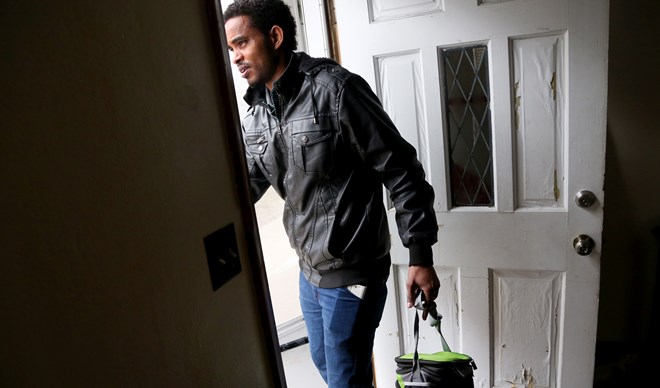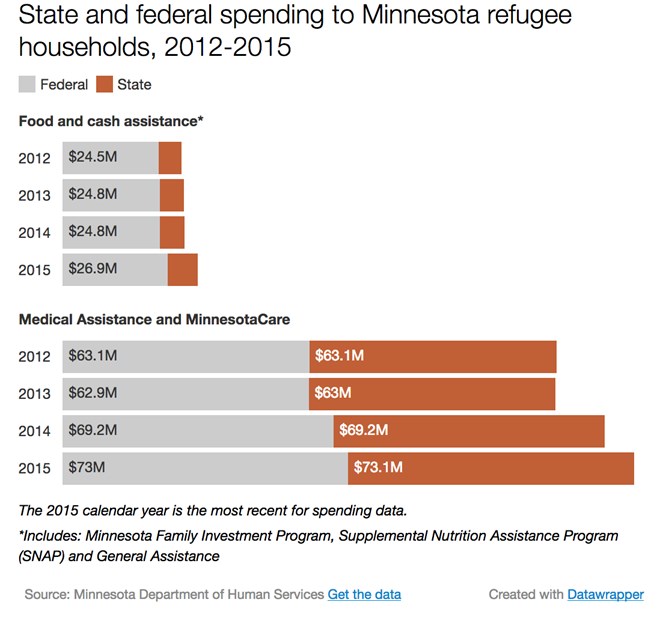
Friday March 10, 2017

The figures come as Minnesota joins national debate over the upfront
taxpayer costs of resettling refugees vs. long-term benefits as they
join the workforce.
Getting in the door: Ahmed Farah, 29, resettled in Minnesota last fall
from Somalia with his family and now works overnights at a warehouse.
Minnesota chips in
generously to help refugees adjust to life in the United States, but
these costs make up a small fraction of the overall tab for public
assistance programs.
Data the
state compiled for the Star Tribune show that Minnesota spent more than
$180 million in state and federal dollars on cash, food and medical
assistance for refugees in 2015, the most recent period available.
That’s up 15 percent from five years ago but still less than 2 percent
of total expenses for these programs. For state-subsidized child care,
however, refugee communities have come to account for more than a
quarter of costs.
“In the short term,
resettlement can be a very fiscally intensive exercise because of the
kinds of needs refugees bring,” said Ryan Allen, an expert on
resettlement at the University of Minnesota’s Humphrey School. “As
people of working age find jobs and become more self-sufficient,
benefits will accrue over time.”
Minnesota
has joined a roiling national debate about how the upfront taxpayer
costs of resettling refugees stack up against long-term benefits as they
join the workforce.
Now, the
Trump administration’s move to pause and shrink the resettlement program
brings fresh attention to the cost question, which Minnesota has never
set out to answer.
Republican
state legislators introduced a proposal last spring calling for an
independent audit of all federal, state, local and nonprofit expenses
for resettlement in Minnesota.
Sen. Bruce Anderson,
R-Buffalo, says the federal government makes all major decisions about
refugee arrivals but passes part of the cost to local communities, where
taxpayers have little clue what they are paying.
“They say, ‘OK, states. You take care of it. You make it happen,’ ” said Anderson, who reintroduced the proposal this year.
In St.
Cloud, retired sales manager Tom Krieg wanted to know what resettling
refugees in Stearns County costs — and he went from the city’s mayor to
county officials to the local newspaper for answers. In response to
queries from Krieg and fellow residents, Stearns County created almost
100 PowerPoint slides on the resettlement process. Krieg says he was
surprised by how few answers were readily available.
“It’s a Minnesota philosophy of, ‘If it looks good and feels good, don’t ask a lot of questions,’ ” he said.
The cost
question is misplaced, some advocates argue. Resettlement is a
humanitarian effort helping some of world’s most vulnerable: single
mothers, people with pressing medical needs, survivors of torture.
To Mark
Sizer, the county’s human service administrator, tackling this question
offers a chance to dispel some misconceptions. He says some residents
asked why refugees get free housing, cars and groceries. They do not.
State bolsters federal aid
New
refugees receive a federal grant of no more than $1,125 to help pay for
rent, furnishings, food and other expenses in their first three months
of arrival. A small number can opt into a federal program that covers
more early expenses, with a push to find a job within four months. The
rest rely on public assistance programs to supplement federal dollars.

Few federally and
state-funded programs here track refugee status. There’s no way to glean
refugee use of unemployment insurance, MNsure insurance subsidies,
Section 8 vouchers and state-run housing subsidy programs, among others.
The state does not know how many refugee students enroll in public
schools.
Over the
past three months, the Minnesota Department of Human Services crunched
the numbers on refugee participation and spending in five assistance
programs at the request of the Star Tribune. Jim Koppel, an assistant
commissioner at the department, says the state doesn’t normally track
these costs because of its commitment to refugees: “We don’t look at the
cost of people coming to Minnesota from Iowa and compare it to the cost
of people coming from South Dakota.”
Spending
for cash, food and medical assistance has gone up as refugee arrivals
increased, from about 1,740 refugees five years ago to 2,630 during the
past fiscal year. That includes a 30 percent increase in a cash
assistance program for families with children, which supported about
10,740 refugee households at a cost of roughly $18.2 million in 2015.
The
federal government covered almost 55 percent of the overall costs,
including the entire $15 million tab for food stamps and half the $144.5
million medical assistance bill. The department said the numbers
capture refugees who move to Minnesota from other states as well as most
who become permanent residents after a year in the country, unless they
choose to update their status.
Minnesota is known among newcomers for its generous benefits, says the state’s former refugee coordinator, Gus Avenido.
According
to a federal comparison, refugees in Minnesota receive $532 a month on
average through its family cash assistance program, compared with about
$430 nationally.
State data
show almost 78 percent of Somalis exit the family cash assistance
program within three years, above the 67 percent of all Minnesotans on
average.
Beyond these programs, estimating costs gets trickier.
In response to a data
request, the Department of Human Services found the state resettled more
than 3,785 school-aged children in the past five years. But the state
doesn’t know how many needed English services. In recent years, the cost
of educating English learners was about $9,790 in federal and state
dollars, compared with about $8,080 for an average student.
For other
programs, the only way to estimate refugee participation or costs is to
use home or preferred language — a flawed substitute because residents
who list, say, Somali could be second-generation U.S. citizens or
newcomers sponsored by family.
Using
language as a measure, one program where the state’s largest refugee
communities account for a sizable portion of the tab is subsidized child
care. Almost 7,500 Somali, 300 Oromo and 200 Karen children received
more than $49.6 million in state child care subsidies last year — more
than a quarter of all expenses, compared with 12 percent five years ago.
Counties
have two main resettlement expenses: interpreting and health care
services. But counties like Ramsey, which has overtaken Hennepin as the
top resettlement destination, don’t separate expenses by refugee status.
Stearns County estimated it spent about $80,000 to coordinate refugee
health screenings and more than $368,000 for interpreting.
Ahmed
Farah arrived in the Twin Cities with his sister and parents last fall
after spending almost 20 of his 29 years in an Eritrean refugee camp.
His father, who uses a wheelchair, qualified for Social Security. The
other family members received $250 each in cash assistance and a total
of roughly $400 in food stamps.
When a
warehouse job came along four months later, Farah hesitated. It would be
a shift from teaching math at the camp to manual labor, with nighttime
hours and more than an hour public transit commute from St. Paul to the
southwest metro.
But he says, “I had to accept this. You arrive, and you have many opportunities, but it takes time.”
Now off public assistance, Farah hopes to get into college and restart a teaching career.
A
cost-benefit look at resettlement would factor in refugees’ economic
contributions — and that side of the equation can be even more
challenging.
Concordia
University professor Bruce Corrie points to his study of the Hmong in
the state between 1990 and the early 2010s. The Hmong poverty rate more
than halved, to about 27 percent; the homeownership rate rose from 12
percent to 47.5 percent; and estimated state and local taxes went up
from $9.5 million to $80 million. Corrie estimated the Hmong have
started 3,200 businesses in the state.
“Even if you admit in the short term there are costs, in the long term you come out ahead,” Corrie said.
A
Migration Policy Institute study found refugee men are employed at a
higher rate than their U.S.-born counterparts and refugee women at about
the same rate as the native born. Refugee reliance on public benefit
programs drops off sharply over time, though it remains higher than for
the native born.
Minnesota
also boasts a growing refugee entrepreneurial class. The
Minneapolis-based African Development Center says its member businesses
created 122 jobs and retained 514 jobs last year.
“When
people are thinking about costs, they think short term,” said State
Demographer Susan Brower. “They are not thinking about the long-term
effect on our workforce.”
Staff
writer MaryJo Webster contributed to this report, as did Jessica Bekker,
a University of Minnesota student on assignment for the Star Tribune.